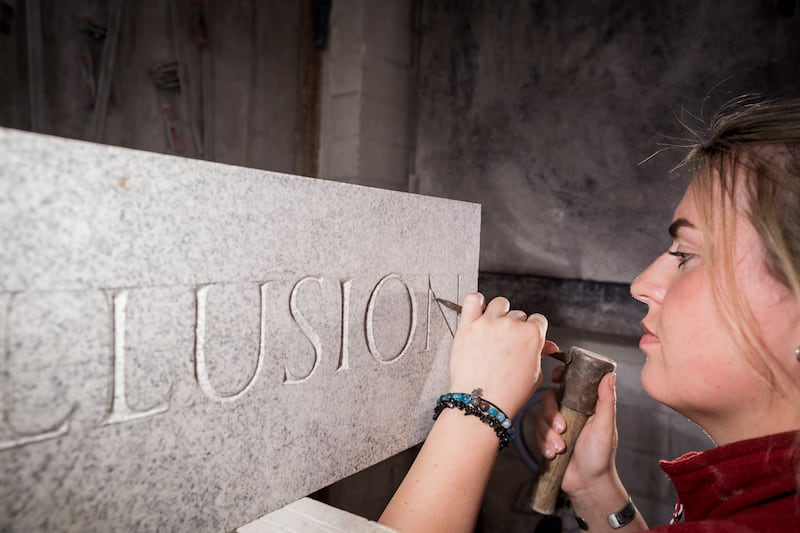Hard work persists but stone lasts forever. That, according to 30-year-old Killian O’Flaherty and his younger sister Petra – eighth-generation stonemason siblings – is the only truism in stonemasonry; and it’s something you’re taught from day one.
Born and raised in the so-called granite village of Ballyknockan – the mountainside Wicklow town famed for its stone, which has been used in many of Dublin’s landmark buildings – their firm O’Flaherty Stone is carving out a name for itself. Ballyknockan granite features in the GPO, the Four Courts, the Custom House, the Bank of Ireland on College Green, Trinity College and the Fusiliers Arch at St Stephen’s Green, which commemorates soldiers of the Royal Dublin Fusiliers killed during the Boer War.
Both Killian and Petra felt destined for the trade, even if it took them 20 years to realise it.
“I feel like we kind of grew up playing with stones and swinging off scaffolding,” Petra, whose name means rock, smiles. She was named by her father after the archaeological city. “Our mam would get our dad to bring us with him to whatever work he was doing if she was busy, and we’d be there making little replicas of what my dad was doing with pebbles right beside him.”

Her brother Killian recalls growing up sitting around kitchen tables with loads of stonemasons from the area.
“We grew up with that, around the fireplaces they’d built,” he says. “And only when you get older do you see another few stonemasons die off and the trade suffers for it. So it kind of comes to a point where you realise that the safest hands are your own and if you want the trade to get better, then you have to do it yourself.”
For Killian, this realisation came halfway through a college degree. Studying architecture at the time, his desire to build and create was hindered by talk of bureaucracy.
“I just felt it was all about building regulations, planning applications and council law – which is very important; don’t get me wrong,” he says. “But it wasn’t what I was looking for.”
He dropped out, opting to pick up work in the trade he grew up with to keep himself afloat – “and the rest is history,” as he says.
Petra, the first registered woman stonemason apprentice in 30 years, had a similar experience midway through a nursing degree.
“I knew when I started taking days off college to work here that something was happening,” she smiles. “I was well able for it and really respected the craft. I always have. I suddenly got to this place where I thought, why was I not already doing this?”
Training for stonemasonry and letter carving comes in many forms and is not for the faint of heart. It requires great strength and great skill.
Among the first projects any aspiring stonemason will undertake within the bounds of their apprenticeship is the cutting of a perfect cube out of a hunk of stone with just hand tools.
“You’re basically learning to use hand tools and being able to square stone off a stone face,” says Petra. “So you’ll have one face but you’ll need to be able to square the rest of the stone off. It doesn’t really matter about the size. The exercise is such that if you mess up, you can drop the line again and start again. So it’s kind of a process of elimination until you get it to work.”

“It’s a fantastic exercise,” Killian interjects. “It might take you six months to do. But afterwards, you have a real understanding and respect for the grinders and pneumatic tools. I’ve had loads of stonemasons – the professionals, now – give out about that process. But at the same time, would they be able to do it?”
Those serious about the business, generally venture to Tralee, to learn from master craftsman Tom Little.
“As soon as you meet Tom you know there’s something special about him,” Petra says.
“And the work speaks for itself,” Killian adds. “He’s a fantastic educator. He’s almost like Mr Miyagi in the film Karate Kid. What he teaches you in stone will fall into your personal life as well. Like being on time and putting in the work and cleaning up and whatever else.”
Little sets high standards, according to the O’Flahertys – “He knows whether you’re a millimetre off just by eyeballing it,” Petra laughs – and is a firm believer that you have to get uncomfortable to get good. The process takes patience. “You’re not going to make something in a week,” Petra smiles.
“But it’s an extraordinary medium to work with because it has the advantage that it lasts,” adds Killian. “You don’t get a lifetime guarantee; you get an all-time guarantee. It doesn’t rot, it doesn’t rust. It might go a little green but that just takes a quick clean if you want to keep it fresh. It’s a fantastic material. I consider myself very grateful to work with it. It takes 10 times longer to work with than, say, timber because it’s so hard – but the juice is worth the squeeze. And the end result will be there for 10,000 years.”

The best kind of stonemasonry is made to go unnoticed. “You can’t walk through Dublin city without seeing a building built by stonemasons,” says Killian. “Heuston Station, the GPO, the Jesuit Church of St Francis Xavier on Gardiner Street – there’s a ridiculous amount and, as they’re all old buildings, repairs are needed too.”
One of the most impressive restorations was made to St Mel’s Cathedral in Longford, which had been destroyed by fire on Christmas Day 2009. Crucial to protecting our most celebrated cultural icons, O’Flaherty Stone is currently doing work for the French embassy on Sydney Parade. Generally, the O’Flahertys procure work by way of heritage or conservation projects and have done restoration work to Dublin Castle and Leinster House. Private work comes through their social media accounts and word of mouth.
Last year Killian was nominated for craftsperson of the year across Ireland, the UK, Scotland and Wales in the under-30s category in the Society for Protection of Ancient Buildings (SPAB) Heritage Awards, where he came fourth. The recognition undeniably boosted the siblings’ business but their hope is that the same thing will happen to the trade overall for there is a resurgence in interest.
While looking back remains crucial to keeping the spirit of the art alive, recent developments have created an optimal environment for stonemasonry to flourish. A huge amount of money has been invested into training and constructing state-of-the-art facilities for apprentices, Killian explains. Demand for quality work has soared, with O’Flaherty Stone winning many prestigious contracts.
“A real consideration has been put into the material we work with. I really think I came into the trade at the right place and right time, and the same can be said today for Petra,” he says.
From a childhood spent around dozens of highly skilled stonemasons carving out pieces of history, the pair have carried on a business whose work will outlive them.
“It’s a job where you really just have to trust your own process; a lot of patience and hard work but the rewards are just incredible,” says Petra.
“The camaraderie and community of it all is brilliant. Even if it can feel cold and miserable at times,” Killian adds counselling anyone who is currently sitting at their kitchen table and not sure what they’re doing with their life, but have always been interested in working with their hands, to learn the craft.
“I could not recommend getting into this trade more. Now’s the time to get into it. In fact, there’s never been a better time.”
For more information on the O’Flahertys work click visit oflahertystone.com.
To read more about a potential career in stonemasonry, go to kerrycollege.ie or phone the Apprenticeship Services Team at Kerry College (Monavalley Campus) on 066 714 9600.














